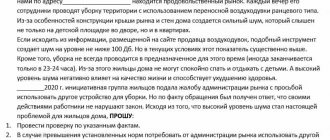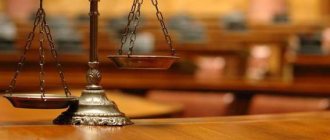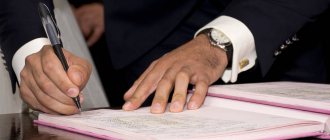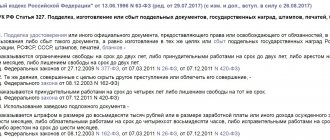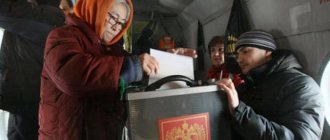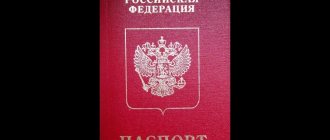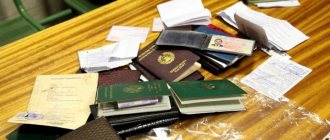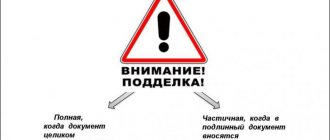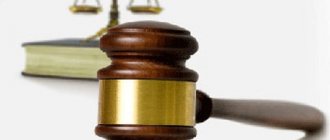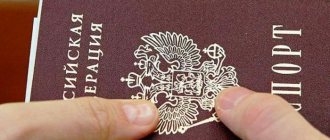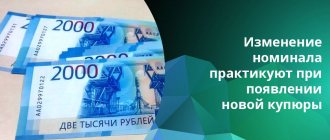Types of counterfeit
There are two types of passport forgery:
- Full.
- Partial.
In case of complete forgery, the document is created from scratch. All its elements are fake, and the document itself will not be listed in the databases of the state that allegedly issued it.
Partial forgery consists of correcting or changing individual elements of the passport. Seals and stamps, photos or some pages of the passport may be changed.
Ways to completely falsify a passport are:
- Production of a new document.
- Creation of forms on which passports are printed.
- Indication of false information in the passport. It is important that when filling out a document, a person knows that the information is fictitious.
- Forging the signature of a migration service officer.
- Creation of new stamps and seals.
Complete falsification of a passport is a complex process that requires special equipment. At the same time, the use of such a document is quite risky, since when it is checked by employees of the competent authorities, it will be easy to prove that such a document was not officially issued.
Partial falsification of a passport consists of:
- Deleting text in the finished document. This is usually done by erasing it.
- Etching parts of the text with chemical reagents.
- Adding new words or characters to your passport.
- Replacing individual sheets or passport photos.
All of the above actions fall under the qualifications of Article 327 of the Criminal Code of the Russian Federation.
Prison car
Notaries also encounter enterprising debtors who are trying not to fulfill their obligations. Two citizens approached one of the notary offices with a request to certify a car purchase and sale agreement. The car is new, purchased at a dealership, but has not yet been registered. This is the first thing that aroused suspicion: a person bought a car a couple of days ago and immediately decided to sell it to a third party, the FNP explained.
Don't lose face
Photo: RIA Novosti/Nina Zotina
— And besides, the man turned to a notary. But according to the law, a contract for the sale and purchase of a vehicle is not subject to mandatory notarization. Having checked the car according to the register of pledges of movable property maintained by the Federal Tax Service, we discovered that the car was pledged to the bank,” the organization explained.
Of course, the buyer in this situation does not know these details. At the notary's office, the buyer was told that the car was pledged and sale was possible only with the consent of the bank. Thus, the actions of the notary saved a respectable citizen from deception.
How to spot a fake?
Considering that criminals can use a fake passport in various illegal schemes, it is worth knowing about the main signs of forgery of this document. These include:
- Requisites. Falsification of this element of the passport makes it possible to determine which device was used to falsify the document.
- Changed color of the form. These passport forms follow strict templates. Any differences in shades indicate a fake passport.
- No watermarks. This security element is very difficult to counterfeit, so this element may be completely absent on low-quality fake passports.
- Various page sizes. This feature distinguishes low-quality fakes, but these can also be found.
- On the laminated pages under ultraviolet light you can see many inscriptions “Ministry of Internal Affairs of Russia”. In fake documents, these elements are few or not present at all.
- Another protective element that is visible under ultraviolet light is yellow and green fibers. They are also difficult to counterfeit at home, so counterfeit passports generally lack such protection.
- On the third page of the passport, a number of lines are printed in microscopic font. This text is missing in fake documents.
- The series and document number are printed in a different shade of ink.
- In some places in the passport, the details are printed poorly. In original documents, all data is printed clearly and without defects.
- Defective lamination. Foreign objects are visible under the film.
- A split or cut in laminate flooring. In fake passports, this cut is usually located at the top of the page.
- Damage around the photo. This is clear evidence of his replacement. In some cases, the new photo is pasted on top of the old one.
- Double layer of laminate. When carefully covering the passport with film, this feature is not immediately noticeable.
- Creases on the cover or endpaper of a document. This is a sign of manual forgery of a passport.
All of the listed signs of passport forgery reflect the difficulties in falsifying it without professional equipment.
Have a question for a lawyer? Ask now, call and get a free consultation from leading lawyers in your city. We will answer your questions quickly and try to help with your specific case.
Telephone in Moscow and the Moscow region: +7
Phone in St. Petersburg and Leningrad region: +7
Free hotline throughout Russia: 8 (800) 301-39-20
And sometimes you don’t even need a passport
You can also search by name in open databases:
- on cases and judicial acts;
- based on the texts of court decisions;
- according to decisions of arbitration courts;
- in the file of arbitration cases (cases that are currently in proceedings);
- on the website of the bailiff service in the register of enforcement proceedings (by full name and region);
- based on a database of people suspected of committing crimes.
It would also be a good idea to look into the Ministry of Internal Affairs’ “Wanted” database and check the passport photo with the list of especially dangerous criminals. By the way, you can get 1 million rubles for helping to find especially dangerous criminals.
Technical and forensic examination of documents
Suspecting that the passport is counterfeit or that changes have been made to it, law enforcement agencies conduct a technical and forensic examination. Use it to install:
- A method used by criminals to produce a fake passport.
- Prove that the original document has been changed.
- They identify damage that is faintly visible or invisible when examining the document.
- Passport production time.
- Means of its falsification.
Sometimes an expert can recognize a fake passport during a routine examination by paying attention to:
- Uneven character of strokes.
- Different sizes of letters and their configuration.
- Non-standard nature of the images.
- Grammatical errors in the text.
- Logical contradictions in the contents of the passport.
- Pencil marks that remain from the moment the passport was prepared for correction.
When changing elements of this passport, the etching method is often used. In this case, the text is removed using chemical reagents. But in the place where they are applied to the passport form, the paint may change its color and blur. Traces of blur may also be visible on text that has been exposed to reagents.
The use of the erasure method is determined by examining the paper against the light. At the point where it is erased, it becomes thin and rough.
Particular attention is paid to signs of photo replacement, because this method is used by scammers to subsequently issue loans on someone else’s document with their own photo. These signs are:
- The oval seal on the photo on the form does not match.
- Sometimes they change only part of the photo, leaving the printed part. In this case, you need to pay attention to differences in photographic paper, discrepancies between parts of photographs and the presence of a cut in the photo.
- Applying a layer of emulsion to the backing of an old photograph. In this case, the unevenness of the photo paper is visible, as well as differences in its quality characteristics.
When determining the partial falsification of a passport, the stamps and signatures of a migration department employee are examined under oblique light using a magnifying glass or microscope, because these are the elements that are most often counterfeited. The remaining parts of the passport are protected by a number of special elements that are extremely difficult to reproduce.
Dangerous moment
A notary puts his life at risk every time he exposes dishonesty in his office or reveals a criminal plot. After all, in fact, he becomes the main witness to the commission of a crime.
Don't lose face
Photo: TASS/Vladimir Astapkovich
— Before certifying a transaction, the notary conducts a thorough legal examination, checks all documents, and personally talks with applicants to clarify important aspects from a legal point of view. That is why it is rare that a fraudster will risk contacting a notary office. However, even if this happens, in most cases the criminal plan is revealed by the notary very quickly. Next, he transfers the information to law enforcement agencies, if necessary, providing a video recording of the visit of the alleged fraudsters,” Vice-President of the Kirov Regional Notary Chamber Anna Korchemkina spoke about the algorithm of actions in case of an emergency.
What does the darknet say?
Naturally, you can find offers to “punch your passport” for the amount of 3-5 thousand rubles. Technically, they can actually extract full passport data by name and region or date of birth from the merged database.
But, firstly, most often this is a divorce , for which there will be no one to file claims against. In addition, the Criminal Code of the Russian Federation has Art. 137 “Violation of privacy”, which establishes liability for the unauthorized use or distribution of someone else’s passport data.
Such actions threaten a fine of 150 thousand to 350 thousand rubles, imprisonment for up to five years, or administrative sanctions. Is it worth becoming an accomplice to a crime? We don't think so.
Secondly, people often talk too much about themselves. You can often find out more from photos on social networks than from passport data. And if you google passport data in the format “full name + city”, “full name + date of birth”, find a person’s classmates and classmates, ask what kind of guy he was... You’ll be surprised how much you can find out.
The main thing is to look carefully and compare. Moreover, this is not prohibited by law, just like requests to open databases.
(
33 votes, overall rating: 4.58 out of 5)
